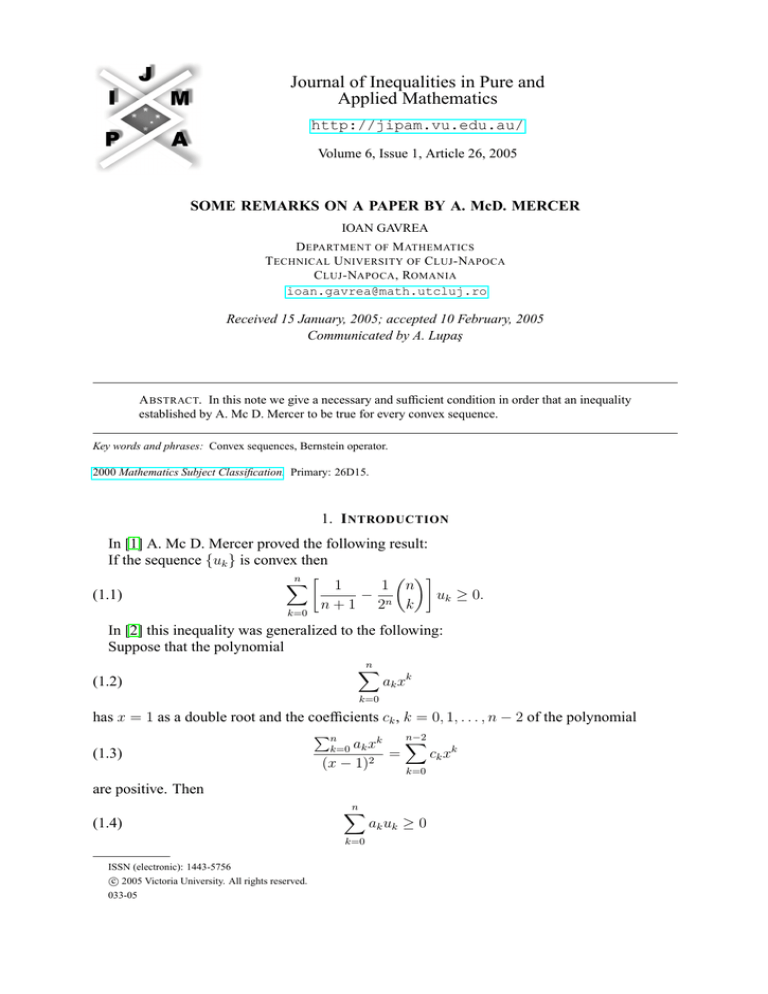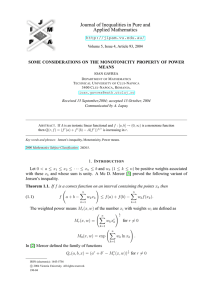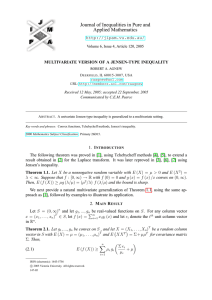
Journal of Inequalities in Pure and
Applied Mathematics
http://jipam.vu.edu.au/
Volume 6, Issue 1, Article 26, 2005
SOME REMARKS ON A PAPER BY A. McD. MERCER
IOAN GAVREA
D EPARTMENT OF M ATHEMATICS
T ECHNICAL U NIVERSITY OF C LUJ -NAPOCA
C LUJ -NAPOCA , ROMANIA
ioan.gavrea@math.utcluj.ro
Received 15 January, 2005; accepted 10 February, 2005
Communicated by A. Lupaş
A BSTRACT. In this note we give a necessary and sufficient condition in order that an inequality
established by A. Mc D. Mercer to be true for every convex sequence.
Key words and phrases: Convex sequences, Bernstein operator.
2000 Mathematics Subject Classification. Primary: 26D15.
1. I NTRODUCTION
In [1] A. Mc D. Mercer proved the following result:
If the sequence {uk } is convex then
n X
1
1 n
(1.1)
− n
uk ≥ 0.
n
+
1
2
k
k=0
In [2] this inequality was generalized to the following:
Suppose that the polynomial
n
X
(1.2)
ak x k
k=0
has x = 1 as a double root and the coefficients ck , k = 0, 1, . . . , n − 2 of the polynomial
Pn
n−2
k
X
k=0 ak x
(1.3)
=
ck xk
(x − 1)2
k=0
are positive. Then
(1.4)
n
X
k=0
ISSN (electronic): 1443-5756
c 2005 Victoria University. All rights reserved.
033-05
ak u k ≥ 0
2
I OAN G AVREA
if the sequence {uk } is convex.
The aim of this note is to show that the inequality (1.4) holds for every convex sequence {uk }
if and only if the polynomial given by (1.2) has x = 1 as a double root and the coefficients ck
(k = 0, 1, . . . , n − 2) of the polynomial given by (1.3) are positive.
2. A R ESULT
OF
T IBERIU P OPOVICIU
Let n be a fixed natural number and
x0 < x 1 < · · · < x n
(2.1)
n + 1 distinct points on the real axis. We denote by S the linear subspace of the real functions
defined on the set of the points (2.1). If a0 , a1 , . . . , an are n + 1 fixed real numbers we define
the linear functional A, A : S → R by
A(f ) =
(2.2)
n
X
ak f (xk ).
k=0
T. Popoviciu ([3]) proved the following results:
Theorem 2.1.
(a) The functional A is zero for every polynomial of degree at the most one if and only if
there exist the constants α0 , α1 , . . . , αn−2 independent of the function f , such that the
following equality holds:
(2.3)
A(f ) =
n−2
X
αk [xk , xk+1 , xk+2 ; f ],
k=0
where [xk , xk+1 , xk+2 ; f ] is divided difference of the function f .
(b) If there exists an index k (0 ≤ k ≤ n − 2) such that αk 6= 0, then
A(f ) ≥ 0,
(2.4)
for every convex function f if and only if
(2.5)
αi ≥ 0,
i = 0, 1, . . . , n − 2.
3. M AIN R ESULT
Theorem 3.1. Let a0 , a1 , . . . , an be n + 1 fixed real numbers such that
inequality
(3.1)
n
X
Pn
k=0
a2k > 0. The
ak u k ≥ 0
k=0
holds for every convex sequence {uk } if and only if the polynomial given by (1.2) has x = 1 as
a double root and all coefficients ck of the polynomial given by (1.3) are positive.
Proof. The sufficiency of the theorem was proved by A. Mc D. Mercer in [2].
J. Inequal. Pure and Appl. Math., 6(1) Art. 26, 2005
http://jipam.vu.edu.au/
R EMARKS ON A PAPER BY M ERCER
3
We suppose that the inequality (3.1) is valid for every convex sequence. The sequences {1},
{−1}, {k} and {−k} are convex sequences. By (3.1) we get
n
X
ak = 0
k=0
(3.2)
n
X
kak = 0.
k=1
We denote by f , f : [0, 1] → R, the polygonal line having its vertices nk , uk , k = 0, 1, . . . , n.
The sequence {uk } is convex if and only if the function f is convex.
Let us denote by
n
X
k
A(f ) =
ak f
.
n
k=0
The inequality (3.1) holds for every convex sequence {uk } if and only if
A(f ) ≥ 0
for every function f which is convex on the set 0, n1 , . . . , nn .
By (3.2) we have
A(P ) = 0
(3.3)
for every polynomial P having its degree at the most one. Using Popoviciu’s Theorem 2.1, it
follows that there exist the constants α0 , α1 , . . . , αn−2 , independent of the function f such that
n−2
X
k k+1 k+2
(3.4)
A(f ) =
αk
,
,
;f ,
n
n
n
k=0
for every function f defined of the set 0, n1 , . . . , nn .
By the equality
X
n
n
X
k k+1 k+2
k
αk
,
,
;f =
ak f
,
n
n
n
n
k=0
k=0
we get αk = n22 ck , k = 0, 1, . . . , n − 2.
Because x = 1 is a double root for the polynomial given by (1.2) we have
n
X
ck 6= 0.
k=0
Using again Popoviciu’s Theorem (b), A(f ) ≥ 0 if and only if ck ≥ 0, k = 0, . . . , n − 2, and
our theorem is proved.
4. A NOTHER P ROOF OF (1.1)
Let us consider the Bernstein operator Bn ,
n
X
k
Bn (f )(x) =
pn,k (x)f
,
n
k=0
(4.1)
where pn,k (x) =
n
k
xk (1 − x)n−k , k = 0, 1, . . . , n.
J. Inequal. Pure and Appl. Math., 6(1) Art. 26, 2005
http://jipam.vu.edu.au/
4
I OAN G AVREA
It is well known that for every convex function f , Bn is a convex function too. For such a
function, we have, by Jensen’s inequality,
Z 1
1
(4.2)
Bn (f )(x)dx ≥ Bn (f )
.
2
0
On the other hand we have
Z 1
1
(4.3)
pn,k (x)dx =
,
n+1
0
1
n 1
pn,k
=
, k = 0, 1, . . . , n.
2
k 2n
Now, the inequality (1.1) follows by (4.2) and (4.3).
R EFERENCES
[1] A. McD. MERCER, An elementary inequality, Internat. J. Math. and Math. Sci., 63 (1983), 609–
611.
[2] A. McD. MERCER, Polynomials and convex sequence inequalities, J. Inequal. Pure Appl. Math.,
6(1) (2005), Art.8. [ONLINE http://jipam.vu.edu.au/article.php?sid=477].
[3] T. POPOVICIU, Divided differences and derivatives (Romanian), Studii şi Cercetări de Matematică
(Cluj), 11(1) (1960), 119–145.
J. Inequal. Pure and Appl. Math., 6(1) Art. 26, 2005
http://jipam.vu.edu.au/





